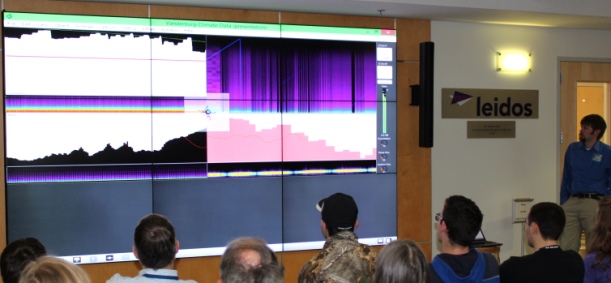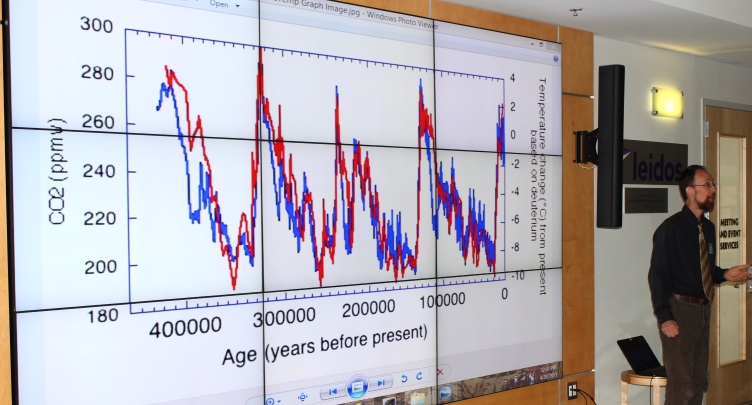CSC News
SC CSC & Students Create Music from Earth's Past Climate
04/29/2015
The South Central Climate Science Center collaborated with the New Improv! Century Ensemble (N!CE) to sonify 400,000 years of atmospheric carbon dioxide and global average temperature data from ice cores and proxy data. N!CE is a student musical group in The University of Oklahoma School of Music that is made up of student composers and very adventurous performers, under the direction of Dr. Marc Jensen. The students worked with the data over the Spring 2015 semester, culminating in a performance of their pieces on Monday, April 20, 2015 at the National Weather Center’s Biennale. Continue to the bottom of the article to find links to the musical interpretations >>
Since the dataset of carbon dioxide and global average temperature contained subtle variations and a large range of values, N!CE felt that sonification could provide a unique perspective on Earth’s past climate. Sonifications run the gamut from very stark data representations, to musical compositions that become artistic interpretations of the source material. Most sonifications fall somewhere between these two poles, with some degree of artistic license balanced against some degree of clear data representation. The degree of interpretive freedom depends on the function of the work.
Our thanks to the following members of N!CE for their work on this project: Zachary Daniels, Kerry Folsom, Marc Jensen, Kyriakos Tsoukalas, and Kyle Vanderburg.
Marc's simple representation - https://www.youtube.com/watch?v=8R5usATRcvQ
Marc's Correlations - https://www.youtube.com/watch?v=xPkTqTioq58
Kerry's Carbon Takeover - https://www.youtube.com/watch?v=VprAs7Or9pc
Kyriakos' Earthly - https://www.youtube.com/watch?v=bLHaJ6Fj6-s
Zach’s Weathered Time - https://www.youtube.com/watch?v=ue-L9xBTilg
Kyle’s Cascades - https://www.youtube.com/watch?v=VxYT-838hI0

Since the dataset of carbon dioxide and global average temperature contained subtle variations and a large range of values, N!CE felt that sonification could provide a unique perspective on Earth’s past climate. Sonifications run the gamut from very stark data representations, to musical compositions that become artistic interpretations of the source material. Most sonifications fall somewhere between these two poles, with some degree of artistic license balanced against some degree of clear data representation. The degree of interpretive freedom depends on the function of the work.

Our thanks to the following members of N!CE for their work on this project: Zachary Daniels, Kerry Folsom, Marc Jensen, Kyriakos Tsoukalas, and Kyle Vanderburg.
Marc's simple representation - https://www.youtube.com/watch?v=8R5usATRcvQ
Marc's Correlations - https://www.youtube.com/watch?v=xPkTqTioq58
Kerry's Carbon Takeover - https://www.youtube.com/watch?v=VprAs7Or9pc
Kyriakos' Earthly - https://www.youtube.com/watch?v=bLHaJ6Fj6-s
Zach’s Weathered Time - https://www.youtube.com/watch?v=ue-L9xBTilg
Kyle’s Cascades - https://www.youtube.com/watch?v=VxYT-838hI0
The South Central Climate Science Center (SC CSC) is part of a network of 8 regional Department of the Interior Climate Science Centers across the United States. The SC CSC is managed through the U.S. Geological Survey and consists of a consortium of institutions, including the University of Oklahoma.




